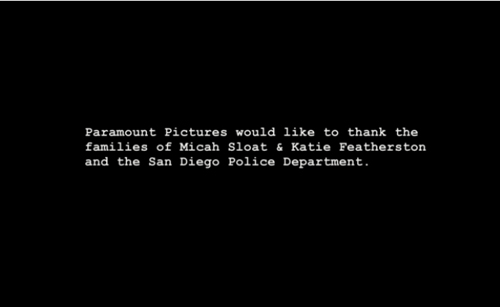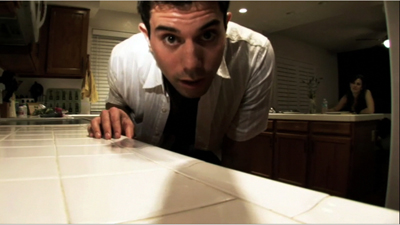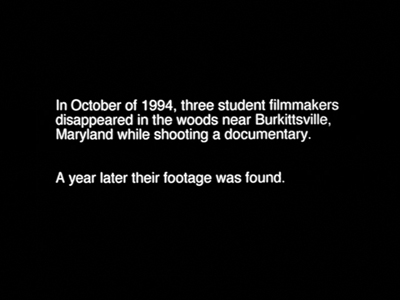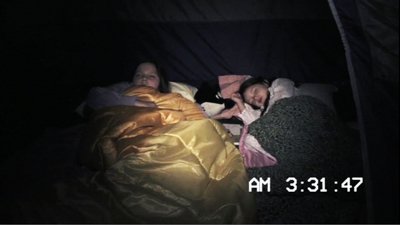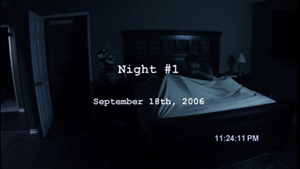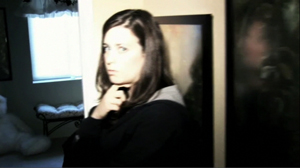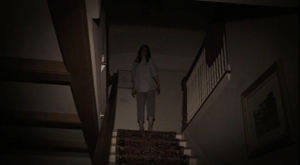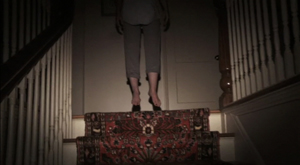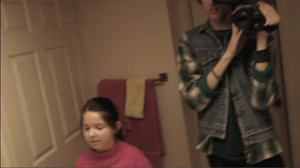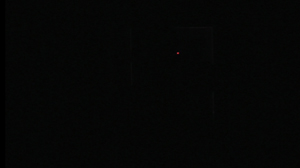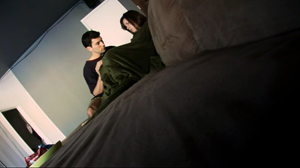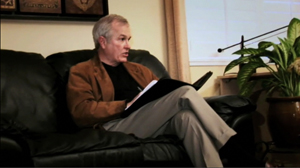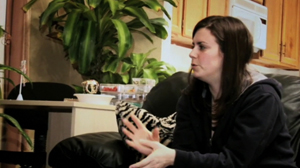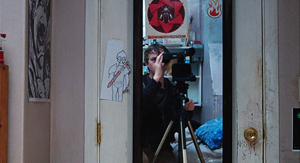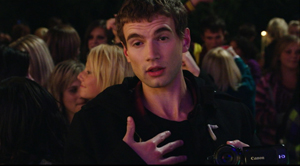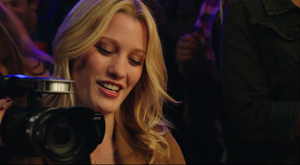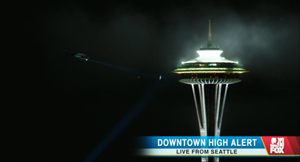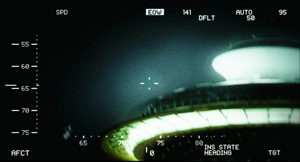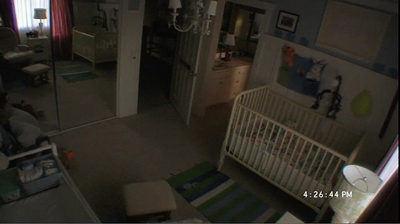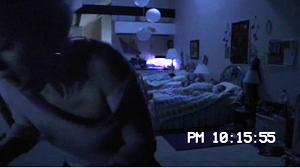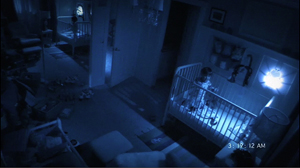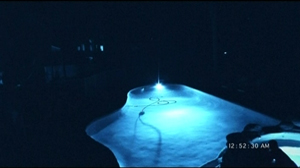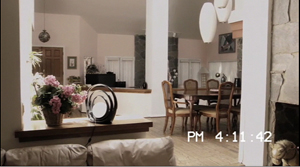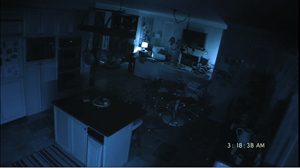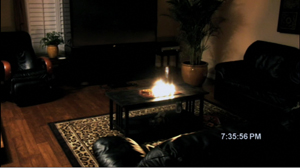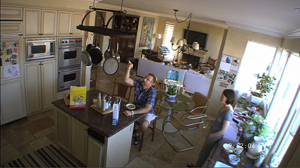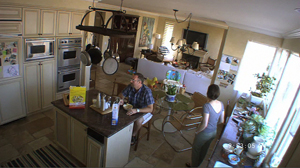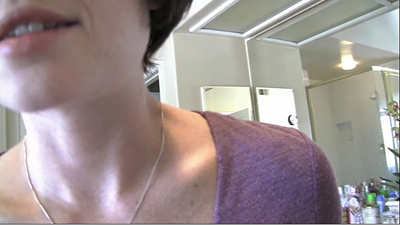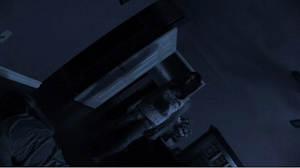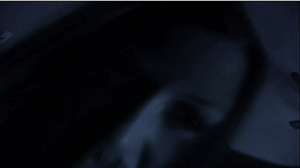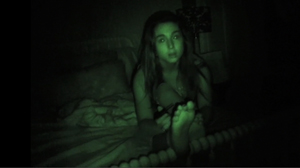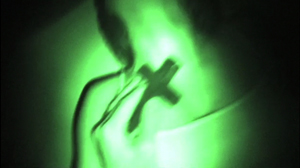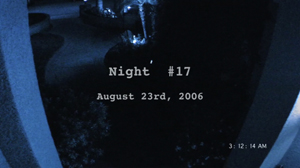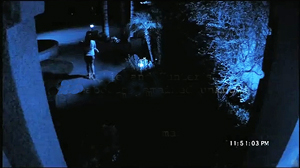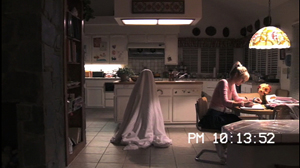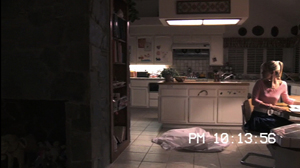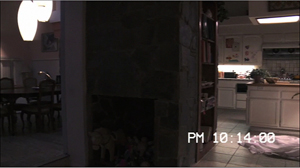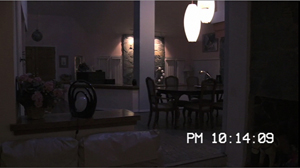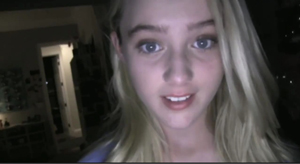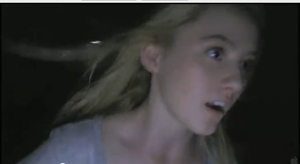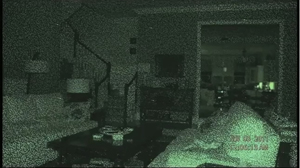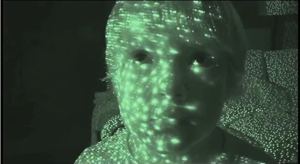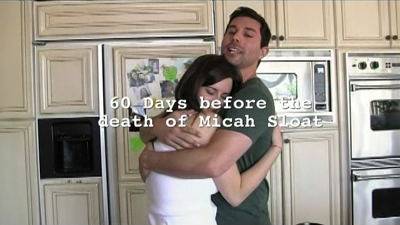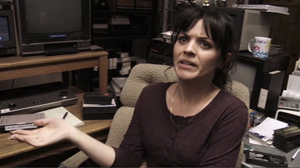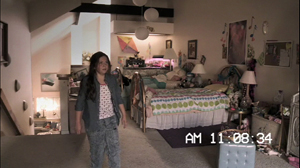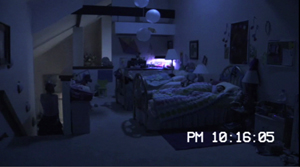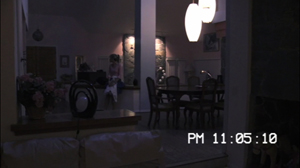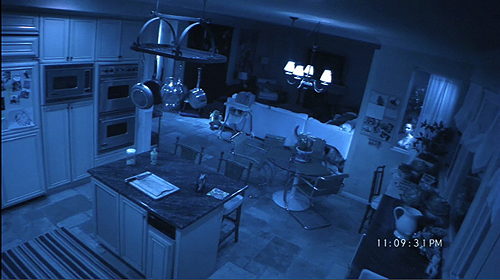Return to Paranormalcy
Tuesday | November 13, 2012 open printable version
open printable version
Paranormal Activity (2007).
DB here:
What is there for me to do? Art historian Ernst Gombrich suggested that this is a problem that confronts every creative artist. If you want to make paintings or compose music or direct movies, you confront an existing community of artists and long-established traditions of art-making. You work with what you’re given. You inherit technology and materials, but you also inherit ideas and familiar conventions and well-worn work habits. You want to find a niche, but you’re also in competition with others for it.
You confront, in other words, a kind of ecosystem with its own history and a current state of play. How can you fit your talents and temperament into that ecosystem? How, more specifically, can you create something different?
Variorum moviemaking
Paranormal Activity (2007).
It can be useful to think of commercial filmmaking as this sort of system, a cooperative/ competitive arena challenging directors, writers, cinematographers, and other film artists to innovate. Innovation isn’t the only aim of moviemaking, of course, and just because something is innovative doesn’t mean it’s good. And not all innovations announce the fact; Jean Renoir’s deft uses of space in his 1930s films didn’t trumpet their originality. Innovation can be quiet and subtle.
Still, as students of the art of film, we’re naturally attuned to novelty—a fresh treatment of an established genre, an unusual approach to characterization, a new application of existing technology. If we’re interested in mainstream film, particularly Hollywood’s, we learn things from the way that filmmakers swarm over something new and try to mimic it or tweak it or turn it around. Make a movie about a possessed pre-adolescent girl who needs an exorcism, and soon we’ll have movies about possessed high-school girls, possessed dogs, possessed cars, and so on.
Call it the variorum quality of popular culture—the tendency to explore, sometimes exhaustively, all the possibilities of a single premise. Filmmakers seize an idea and run with it, in different directions. Of course they may be asking, “How can we cash in on this trend?” but in order to answer that they have to ask another question: “What if we did such-and-such differently?” Even if you start by trying to make money, you still have to make a movie. And that movie will need to be minimally distinctive. The question for the filmmaker remains: What is there for me to do?
Something like this process is going on under our noses. Paranormal Activity (2007), Paranormal Activity 2 (2010), Paranormal Activity 3 (2011), and Paranormal Activity 4 (2012, released in October) have become a cheaply made but very successful franchise. Taken together, the four films have won estimated worldwide box-office revenues of $700 million and counting.
Their popularity offers one reason to examine them, but a better reason is that they make the variorum dynamic unusually clear. The originator and director of the first installment, Oren Peli, and the directors who followed (Tod Williams for the second entry, Henry Joost and Ariel Schulman for the last two, along with continuing writer Christopher Landon) were obliged to innovate within very tight limits. From movie to movie, they came up with fresh and unexpected solutions.
This isn’t about proving these movies to be masterpieces or stinkers. Whatever you think about the quality of the innovations I’ll be looking at, they offer us some leads about how filmic storytelling can change under the “selection pressures” of American commercial cinema.
More strikingly, the Paranormal Activity franchise is that rare thing: a popular series that stands out by very specific and noticeable uses of film technique. Audiences eat it up. The suspense and surprises are part of the appeal, certainly, but there’s reason to think that at least some viewers look forward to following each entry’s formal dynamic of familiarity and variation. Filmmaking becomes a kind of gamelike performance that coaxes us to ask: How will they deal the cards this time?
Of course there are spoilers from here on. Even the pictures contain spoilers.
The same, please, only different
The Blair Witch Project (1999).
The broad task that Peli faced when he began work on Paranormal Activity was clear: How to make a diabolic-possession film different from the others? By then, and still, that variant of horror was pretty well-defined. And indeed the film Peli came up with wasn’t that original in outline. A couple is disturbed by mysterious noises and actions in their house. They call in experts and try to find the source of the disturbance. Eventually the woman becomes possessed and kills her lover.
Throughout, the conventions of the supernatural film rule: sudden blackouts, bone-shaking noises emitted by offscreen fiends, and characters exploring basements, closets, moonlit yards, and other scary spaces. Special effects are invoked to levitate victims or drag them by unseen hands. Occasionally we’re faked out by scares launched as pranks that some characters pull on others. As usual, normal, i.e. bourgeois American life, is devastated by supernatural forces. Cozy domestic surroundings, including an array of consumer goods, become menacing. Much of all this was pioneered by The Exorcist (1973), so the tradition has plenty of cobwebs on it.
Shooting in seven days on a small budget, Peli settled on a formal framework that borrowed from another tradition, that of the pseudo-documentary fiction film. This too goes far back, to This Is Spinal Tap (1984) and Bob Roberts (1992), and before to Stanton Kaye’s Georg (1964), Jim McBride’s David Holzman’s Diary (1967), and Mitchell Block’s No Lies (1972) , and Peter Watkins’ Culloden (1964) and The War Game (1965). More distant predecessors might be Welles’ 1938 War of the Worlds radio broadcast, or even the fake memoirs we find in the early years of the novel. Today the pseudo-documentary mode, used for comic or dramatic purposes, is familiar to us from television shows like The Office. This mode has its own conventions, such as to-camera interviews and the occasionally awkward framing, most noticeable in the recurring image of a fallen camera.
The pseudo-documentary approach had been tried in the horror film in the 1980s, but it gained attention at the end of the 1990s with The Last Broadcast (1998) and The Blair Witch Project (1999). No surprise: Horror films tend to be low-budget items, and shooting in a run-and-gun manner, with handheld shots and awkward sound, was both cheap and realistic-looking. A cycle emerged, exemplified most notably in the bigger-budget Cloverfield (2008).
The problem of the pseudo-documentary is to motivate the fact that someone is filming these dramas. Various solutions have been worked out. You might make the protagonist a filmmaker exploring a subject or creating a diary. Or you can pretend that the people being filmed are celebrities (as in Spinal Tap). Or make the act of filming an effort to document dramatic occurrences. Filmmakers face a second problem as well: motivating how the film has been made public. You can, for instance, present it as a TV or theatrical documentary, as Spinal Tap purports to be. More recently another solution has been found. You can suggest that this film has been discovered after the events were over.
Because of this rationale, the approach is sometimes called the “found-footage” treatment, or in Varietyese the “faux found-footage film.” I’m not delighted by this term because for a long time “found-footage” has referred to films like Bruce Conner’s A Movie or Christian Marclay’s The Clock, assembled out of existing footage scavenged from different sources. So I’ll call fictional movies like Blair Witch and Cloverfield “discovered footage” films.
One reason for this name is that these films hark back to an early tradition of literary fiction, that of the “topos of the discovered manuscript” or “the old oak chest.” Here a tale is presented as a manuscript found and prepared for publication by other hands. The purpose, at first blush, is to give the story an air of authenticity. The same urge prevails in the discovered-footage horror movies, which use this blatant artifice to play with the possibility that these weird happenings really took place. As the image surmounting this blog entry suggests, Peli linked his film to this tradition, even letting the all-too-real company Paramount Pictures attest to the veracity of what we’re going to see.
The development of the Paranormal series took place under the sign of rivalry. A great many horror films of the late 2000s and early 2010s used the pseudo-documentary approach, sometimes marking the footage as recovered. After the success of Peli’s original film, intense competition emerged. There was a blatant ripoff (Paranormal Entity, 2009), followed by many others, including the subtler pseudo-doc The Last Exorcism (2010), which seems to presume that we’ll take it as a found-footage item too.
Just as important, in making successors to the original film, Peli and his colleagues had to compete with themselves. So they freshened up their plots. Paranormal 2 features not a live-in couple but a family; Paranormal 3 centers on an unmarried mother, her live-in boyfriend, and her two daughters. Paranormal 4 features a family whose neighbors are a possessed mother and son.
Interestingly, the subsequent films supply relatively little mythical or doctrinal backstory. Although there are always one or two scenes in which the characters launch on some research, the plots mostly minimize exposition about the hows and whys of possession. (Contrast The Exorcist.) We get just enough hints to assume that there’s a demon who offers women worldly goods in exchange for innocent boys’ souls. Mostly the films concentrate on the characters’ responses, chiefly their quarrels about whether the weird happenings are supernaturally caused. Each film needs at least one blocking character, somebody whose skepticism, obstinacy, or cluelessness keeps the plot going and prevents the characters from simply getting the hell out.
The films also vary protagonists and the characters we’re attached to. Micah moves the plot forward in the first entry with his urge to document the weird happenings, while in the second, the father Daniel and his daughter Ali take turns probing what’s going on. In the third film, again it’s mostly a male filmmaker, Dennis, who propels the inquiry, while in the latest iteration, the narrative momentum is passed to the inquisitive teenage girl Alex.
Perhaps the most up- to-date way the filmmakers refresh the franchise is by making the various films interlock. The films set up a chronology that positions the original release as the third phase of a larger action. Paranormal 2 occurs just before the events of the first one, and Paranormal 3 flashes back eighteen years to supply some preconditions for the previous entries. Moreover, some portions of the plots overlap, so that scenes from one installment are replayed in another, explaining how the time frames mesh. This sort of shuffling with time and perspective is nowadays common both within films and across them; the second and third Bourne films offer good examples.
Above all, the filmmakers have created a new ecological niche by virtue of some initial stylistic choices Peli’s first film made. They were striking but exceptionally constraining. To produce more Paranormal films created a very specific set of problems: How to respect those initial constraints and yet rework them in unpredictable ways?
Hand-eye coordination
Paranormal Activity 3 (2011).
Cloverfield and The Blair Witch Project use the discovered-footage format to justify their amateurish look. These are on-the-fly records of some pretty strange phenomena. By contrast, the Paranormal Activity series doesn’t limit itself to handheld footage. It sets up a dynamic between that and something quite different: the fixed, distant shot reminiscent of surveillance footage.
The alternatives are laid out in the first film, when Micah, perplexed by the ghostly goings-on, buys a fancy video camera and sets it up in the bedroom he shares with Katie. That way he can capture what’s happening while they are sleeping. At other times he takes the camera off its tripod and shoots the house in the usual handheld, eyewitness way.
The result is a movie, and a series, with two markedly different visual treatments. The handheld footage is pure subjectivity, showing exactly what the camera operator sees. It responds immediately to what’s out there, panning or moving toward things of interest. It also permits fairly close shots of the other characters. By contrast, the locked-down shots are completely objective, recording in the manner of surveillance video. Indifferent to human intentions, the camera may be poorly placed to capture what’s happening. And it’s by and large committed to very wide and distant views, compared to the closer views yielded by the probing handheld lens.
Take the handheld technique first. This yields a severely restricted range of knowledge, as I’ve already discussed in relation to Cloverfield. This narrow range is suited for a film playing up mystery and suspense. In any given scene, we don’t know any more than the camera operator does. But of course this feature is also a drawback, because the filmmaker can’t build suspense through crosscutting—showing, say, a door creaking or a shadow moving somewhere else in the house.
The default for most fiction films is camera ubiquity. That is, in principle the camera can be anywhere and show us anything. If the camera doesn’t do that, you need special justification. So for thrillers or horror films, you can show just advancing feet or clutching hands or scary shadows, because we know that these genres promote gaps in our knowledge. We accept the obvious suppression of information.
Another way to justify not showing everything is attachment to one character’s range of knowledge. This is another common strategy of suspense and horror. Even more restrictive is an optical point-of-view treatment, which might be the polar opposite of camera ubiquity. Hitchcock was particularly keen to find ways he could drill into optical point-of-view as a narrative device.
Treating the camera as a vehicle for subjective POV can yield some sudden shocks. One of the most provocative ones in the Paranormal franchise occurs in the third installment, when Dennis approaches Julia at the top of the stairs. His camera-eye viewpoint makes her seem to be standing there, but as he approaches the perspective changes and we see that she’s actually floating.
In the same installment, the “Bloody Mary” encounter in the bathroom gains force not only through the camera’s limitation to Randy’s optical pov, but through the mirror that in the darkness reflects only the red dot of the camera’s “on” signal. It’s all we have to look at in a scene in which the sounds of thrashing and smashing overwhelm the image.
So the handheld subjective camera of Paranormal Activity and other films in the trend avoids camera ubiquity. This creates familiar problems, but filmmakers in this stylistic cycle have come up with solutions.
*How do you explain why the camera is recording this drama? The standard justification is that a crew has decided for some reason to make a movie about something, as in Spinal Tap and The Last Exorcism. Paranormal Activity finds two more pretexts. The video camera can record home movies in Daddy-cam fashion; this motivation is especially important in Paranormal Activity 2. Or the camera can serve to document the weird goings-on in the demon-haunted homes. This motivation is especially strong for the locked-down surveillance recordings.
The camera operator may be the protagonist or at least a major character. How do you show the character to the audience? Options: Have him or her shoot the act of filming in a mirror (very popular). Have him or her address the camera when it’s resting. Let other characters wield the camera and show the cameraperson. Or set the camera down and let it keep filming, often risking decentered compositions but still indicating things clearly enough.
Sometimes you want camera ubiquity. Shot/ reverse-shot cutting is especially valuable because it can emphasize major lines of dialogue and reactions. How can you achieve this in the subjective-camera style? By cheating a little. For example, a single-camera record can capture the give-and-take of a conversation only by either framing both people in a single shot or by panning between them. If you want proper shot/ reverse-shot cuts you have to use overlapping sound during editing to cover the moments when you stopped the shot or panned to reframe the other character. Even when you establish that two cameras are filming the action, you may have to cheat on position quite a bit. (See this discussion of a scene in The Office.)
Chronicle offers an intriguing example of how these problems can be solved. At the beginning Andrew, shooting into a mirror, explains that he has decided to film everything.
Throughout the early portions of the movie we get only what his camera sees, usually with him behind the viewfinder. But eventually we meet Casey, a young woman who has a camera too. The result is shot/ reverse-shot cutting justified as each camera’s viewpoint.
At the climax, when the boy superheroes fight it out above the city, so many people are filming the scene with cellphones, TV news cameras, and government surveillance, that the action is covered fully from many angles. The visual storytelling achieves camera ubiquity.
The impersonal view
Paranormal Activity 2 (2010).
Many horror films have used the handheld approach, but the strongest innovation of the Paranormal series, I think, is the idea of counterweighting the free-camera shots with fixed-camera footage. Like the moving handheld shot, the locked-down surveillance shots avoid camera ubiquity and restrict us severely. But they have other advantages.
As we’ve seen, the fixed setup complements the human-centered handheld camera. It shows everything in front of it indiscriminately. By prying itself loose from the characters, and filming them while they’re not aware of it—especially when they’re sleeping—it allows us a more neutral sense of the film’s space and the things that happen in it. Just as important, it fits smoothly with some standard horror conventions.
For example, offscreen threats are central to the horror film, and the fixed camera can maintain their effects. As (bad) luck would have it, the cameras set up in Paranormal Activity aren’t always ideally framed for showing everything. Very often they merely suggest the demon’s pursuit of the characters. The demon Toby is just off left of frame in the third installment (he blasts some air at the babysitter Lisa) and some entity like Toby seems to be at work offscreen right in the second one, attracting Hunter’s attention.
Likewise, offscreen sound is crucial to the horror film, as Val Lewton and Jacques Tourneur showed long ago with the sudden intrusion of bus brakes into a suspenseful pursuit in The Cat People. The fixed camera can capture those sounds but because no human agent is behind it, there’s no way it can move forward to explore their sources, as a camera operated by a human might.
The surveillance shots, while limited visually, provide information that the subjective shots don’t. In the first film, while Micah sleeps, the bedroom-cam shows some weird goings-ons that he isn’t aware of—notably, Katie getting up and standing unmoving by the bed for several hours. In later installments, the presence of more than one surveillance camera can provide story information via crosscutting. As with Chronicle, multiplying surveillance views pushes the visual narration toward a more complete (and conventional) coverage of the action.
Crucial to the films’ innovation is the fact that the locked-down shots are distant views. The films have extraordinarily few shots for contemporary productions: about 230 in the first part, about 500 in the second (because of the multiple cameras), about 230 again in part three, and about 320 in the last. The number of setups is greater than these figures would suggest because some cuts are jump cuts or drop-frames within extended camera takes.
Long-take, locked-down shots are common in “festival cinema” but virtually unheard of in mainstream Hollywood film. Remarkably, we have box-office hits consisting of long, static takes that hold multiplex audiences in thrall. Of course the long “empty” takes are recruited to the conventional cause of sustained silence and sudden, startling outbursts. The genre, we might say, motivates the style. The same audience wouldn’t be so tolerant of a protracted shot in Tarkovsky or Hou.
Yet we shouldn’t dismiss these shots as mere gimmicks. Their stillness encourages us to scan these spacious frames for hints about what will happen next. The impersonal lens often lingers on bare spaces, and when something of interest happens we won’t be given a cut in. Sometimes the crucial action is barely there, as when Ali and Brad are hidden in shadow, behind the digital read-out, in the lower right of this shot.
To some extent, the distant framing of the surveillance shots revives classic staging techniques in a cinema that seems largely to have forgotten them. Instead of the barrage of close-ups and rapid shot changes we get with today’s intensified continuity style, we get lengthy, static, often indiscernible images we have to scour for clues.
Granted, often those clues are signaled through slight movements, as in the eerie twirling of the toy spider suspended over Hunter’s crib (top of this section). Centering is also important, as when the Ouija board’s planchette scuttles around and then bursts into flames. Sometimes a character can point to what’s important in the visual field.
For the most part, the static framings yield deep, dense compositions reminiscent of 1910s tableau cinema. In the second installment particularly, key bits of action are pushed very far from us or isolated in apertures. The kitchen camera setup lets Ali’s distant face poke up from the sofa into bare visibility (immediately below), or be framed in the window when she tries to get back in as Abby the dog approaches the locked door. (See bottom of this entry.) Unlike most modern films, these lose a great deal of information on small screens.
Overall, the handheld POV shot and the detached and distant long shot complement each other. Both are well fitted to the demands of the horror film, which requires secrets to be concealed from the characters while throwing out hints to us. Beyond genre conventions, though, these films might train the young audience to be patient and learn to settle into images that ripen slowly and don’t yield their meanings up immediately. Well, I can dream, can’t I?
Stretching the rules
Paranormal Activity 2 (2010).
I’ve spoken of these films in general terms, but what makes the series particularly intriguing to me is the development from one installment to the next. The makers aren’t only competing with other filmmakers; they’re competing with themselves. Each new episode has to innovate within the framework they’ve set up—not only by expanding the story action, as we’ve seen, but also by varying the stylistic parameters. That generates new problems, self-imposed ones, and the search for new solutions.
The original Paranormal Activity sets up many of the stylistic premises of the series: the use of mirrors to introduce the camera and its operator, the idea that the investigator will replay the locked-down footage (and then film that with the handheld camera), and the need for at least one skeptical character who will resist the investigation. Here Micah has one camera, which he carries with him by day and installs on its tripod at night. And the resolution of the film is played directly to the camera, as Micah slips out at night to follow Katie and after a long pause is hurled back into the camera, smashing it to the floor. The tipped-over framing records Katie creeping forward, smiling, and roaring into the lens—her revenge on the filming she hated from the start.
Paranormal Activity 2 is largely a prequel, taking place about a year before the first one. Now the single camera is a daddy-cam, recording the arrival of Hunter, the baby born to Daniel and Katie’s sister Kristi. This camera is really a daughter-cam, because it’s mostly wielded by Ali, Daniel’s daughter by a previous marriage. She drives the investigation, but she’s initially more thrilled than afraid. (She also wonders if the ghost is her mother.) The situation shifts from a live-in couple (Paranormal 1) to a happy nuclear family (Paranormal 2) and from a midrange income level to a very prosperous one.
After the house is mysteriously ransacked, Daniel installs a home surveillance system. Six high-angle cameras cover the house. They’re trained on the front door, the back pool, the kitchen, the living room, Hunter’s room, and the master bedroom. In addition, we have Daniel’s Daddy-cam, now outfitted with night vision. This will become important in the climax, allowing us to glimpse, spasmodically, the demon’s response to the attempted exorcism of Kristi.
Naturally all these cameras yield a much-expanded range of knowledge. Now we can see at least part of what’s going on in various parts of the house, and the narration cuts freely from one room to another. Because of the shot scale, though, quicker cutting means that we have to run fast checks in each shot on whether anything seems dangerous.
Important shifts toward camera ubiquity, these new setups also can play a game with our expectations. For example, the eerie shots of the swimming pool at night show the bobbing pool cleaner sidling through the water. Yet Kristi points out that every morning the cleaner has been removed from the pool. The surveillance shots we see never show this, and not until late in the film, when other stretches of the surveillance footage are played, do we see it leave the water. Even sneakier is the tendency of the night footage to mislead us about what’s important. Nearly every night sequence begins with a shot showing the front stoop of the house, but nothing (so far as I can tell) is ever revealed by these images in Paranormal 2, though at the start of Paranormal 4 they pay off by showing Katie leaving with Hunter in her arms.
In context, Paranormal 2‘s recurring shot serves to announce a new sequence of hauntings, but it’s also a little amusing. The standard shot showing a safe household, with no one approaching, serves simply to remind us that the demon is already comfortably inside.
Paranormal Activity 3 is a more distant prequel, setting up the childhood of sisters Kristi and Katie. Here the novelty is the use of VHS tape to record the action. Again, the footage begins as Daddy-cam shooting, as Dennis films Katie’s eighth birthday party and then starts to make a sex tape with Julie. But when the spooky hijinks start, the man of the household decides to investigate. Unlike Micah, though, Dennis is a videographer by trade and so has three cameras at his disposal. He uses one as a handheld device, occasionally set up in his and Julie’s bedroom. He installs another camera in the girls’ bedroom and puts the third one downstairs.
Reducing the “panopticon” of the previous installment from seven to three might be seen as a step backward, but the filmmakers have a clever innovation up their sleeve. Dennis can’t cover the downstairs adequately with his remaining camera. Out of a table fan he constructs a swiveling base to which he can attach a camera. This yields a panning back-and-forth framing.
Of course this mechanical panning is just as little concerned with items of human interest as the static shots of the earlier installments. Indeed, it maintains the horror-film convention of ominous offscreen action, but motivates it as impersonal scanning. The camera slowly reveals pieces of space, but if something exciting starts to happen onscreen, the camera relentlessly turns away.
Set in 2011, Paranormal Activity 4 is the first chronological sequel to the first entry, with a new cast of characters involved in action long after the initial demon outbreak. In some ways, making a teenage girl the protagonist is more conventional than the early films’ focus on couples. Still competing with themselves, the filmmakers needed to recast the series’ stylistic premises. They seem to have asked: Well, who uses dedicated video cameras today—especially if our characters are mostly teenagers? Accordingly, the franchise’s signature seesawing between handheld imagery and locked-down recording is now provided by cellphones and computers.
Although some footage purports to come from a video camera, most of it doesn’t. Alex and her boyfriend Ben set up four laptops around the house, all constantly recording what transpires in the rooms. This tactic allows some changes in the surveillance footage. The camera angle is typically lower than in Paranormal 2, since the laptops are sitting on tables or counters. Moreover, their framings can shift. In the boy Wyatt’s room, his laptop is sometimes closer or farther away, and is sometimes blocked by masses of blankets. The kitchen laptop is shifted around when Alex’s mother moves it closer to her work area.
In addition to recording the household’s supernatural doings, the laptop device lets the teenage heroine Alex have video chats with her boyfriend Ben. In the earlier films we get occasional to-camera monologues, but here we watch Alex talk close to the lens, directly to us, and at length; we see what Ben sees, and sometimes we see him from her screen’s vantage–a sort of virtual shot/ reverse-shot.
At crucial moments Alex picks up the laptop and carries it around with her. As a result, we get more conventional horror-film images of the protagonist—ideally an easily startled young woman—moving through space. In the earlier films, the camera operator’s reactions were given through the subjective framing and offscreen comments, curses, and yelps. Now when Alex hurries across the street to Robbie’s mystery house, we see principally her face.
Ariel Schulman acknowledged that the laptop device adheres to the “rules” of the franchise and the genre while producing, for the first time, conventional close shots of the camera operator. “We were really psyched just to do a shot where the girl’s carrying a laptop, and it’s just filming her. . . It just seemed like a really fun way to carry a camera and film ourself because otherwise there’s no other way to shoot close-ups in a ‘Paranormal’ movie.” Henry Joost adds: “The close-up on a teenaged girl’s face being scared is a horror movie icon. . . . If it’s dark, the only light is from the laptop screen, which is scary. It has all the right ingredients to be in a horror movie.”
Finally, in an innovation parallel to the night-vision footage of part two and the swiveling camera of part three, Paranormal Activity 4 incorporates Xbox Kinect technology. The gadget projects a blast of green dots into the living room, and these can be picked up by night-vision video. One effect is to make Robbie even more ghoulish.
Consistent with the perceptual teasing in earlier films’ extreme long-shots, the Kinect grid also signals the demon’s presence by slight contours, most jolting when the dots shift a little to betray phantom movement. As the earlier entries used powder or dust to track the invisible demon, Paranormal 4 enlists a higher-tech sort of particle. Like the other innovations, it shows that the creators needed not only new situations and plot twists but new variants on their stylistic premises.
Who’s there?
I haven’t yet mentioned one creative problem discovered-footage filmmakers need to confront. Who’s responsible for what we see?
The Paranormal films are obviously assembled. They often have superimposed titles, as above and at the start of the night hauntings. The very first one, at the top of this entry, suggests that something dire will happen to our protagonists; otherwise why ask the families for permission to show the footage?
Editing and camera tricks show the hand of some coordinating intelligence. Some scenes fade out and the night scenes typically start with a fade-in. Locked-down scenes consuming hours are sometimes run fast-forward. We even get dialogue hooks. Randy says, “Just watch the fuckin’ tape, Dennis.” Cut to Dennis watching the tape. In the multiple-camera entries like 2 and 3, there’s cutting from room to room, sometimes following characters through the house. There’s also crosscutting for traditional suspense effects, as when Julie and Dennis are quarrelling while Katie is terrorized by Toby upstairs.
The multiple-camera films betray some perverse humor. We cut from the babysitter Lisa’s terrified retreat from the girls’ room to a shot, about an hour later, of her waiting anxiously by the door for the parents’ return so she can get out as fast as possible.
And sometimes the series of shots is deliberately misleading, dwelling on vacant spaces and failing us to show the characters doing crucial things. Some agent who wanted to convey basic information would provide a more concise set of extracts. This assembler wants to build suspense.
Cloverfield presents itself as a government file, presumably collected and joined by analysts. But Chronicle and The Last Exorcism don’t bother to explain how the recovered footage was discovered, let alone assembled. It’s as if, by this point in the development of the cycle, these marks of authenticity can be omitted.
As usual, the Paranormal series is a bit cagier. With opening titles indicating that the footage is in official hands, the films suggest that these too are from an ongoing investigation of Katie and her family. But I wouldn’t put it past some future installment to center on the unseen collators and editors who have provided us with these shocks and thrills.
In any case, problem-setting and problem-solving remain. The filmmakers have pursued the implications of a narrow set of stylistic choices, and that pursuit comes with both rewards and risks. Meanwhile, other filmmakers may take up the challenge and try to surpass what this series has achieved: limited but genuine experimentation within mainstream conventions. Competing with each other and with their own achievements, filmmakers are pressed to discover new, if narrow, niches in Hollywood’s ecosystem.
E. H. Gombrich’s comment about artists’ tasks comes from his interview with Didier Eribon, Looking for Answers, p. 168. George Watson has some brief but helpful comments on fake memoirs and the discovered-manuscript convention in The Story of the Novel, pp. 15-22. Wikipedia includes a useful list of pseudo-documentaries and discovered-footage here, but calls them “found-footage films,” as most horror aficionados seem to do. As I indicate in the entry, that term confuses these fiction films with what has for a long time been a genre of experimental filmmaking. See for an overview William Wees’ 1993 book Recycled Images: The Art and Politics of Found Footage Films.
On Paranormal Activity, a helpful chronology is available at Dread Central. The chronological collection of the first three films available as a download includes a few extra scenes but omits some things as well, including some of the “official” titles marking the material as recovered footage. In an incisive analysis, Nicholas Rombes praises Paranormal Activity 2 as verging on avant-garde cinema.
Series creator Oren Peli has also directed The Chernobyl Diaries (2012), which has a pseudo-documentary quality at times. More peculiar and puzzling is the film Catfish (2010) by Henry Joost and Ariel Schulman. Many viewers and critics were unsure whether Catfish was a straight documentary or a reenacted one, perhaps with fictional elements added. Whatever the case, it made Joost and Schulman likely candidates for directing the last two installments of the Paranormal franchise. Schulman discusses the transition to studio filmmaking here, while also filling in some background on the Paranormal team’s working methods.
I regret that some of these illustrations are tiny, but I would have had to make them very large for full visibility, and then their quality would have suffered (and the entry would have been even longer). As should be evident, these films need to be seen on a big screen for all their details to be clear.
For a more disconcerting experiment in mechanized camera pickup in a fiction film, see Lars von Trier’s The Boss of It All (2006), discussed here.
Paranormal Activity 2 (2010): On the right, Ali peers in the window as Abby approaches, sniffing.












